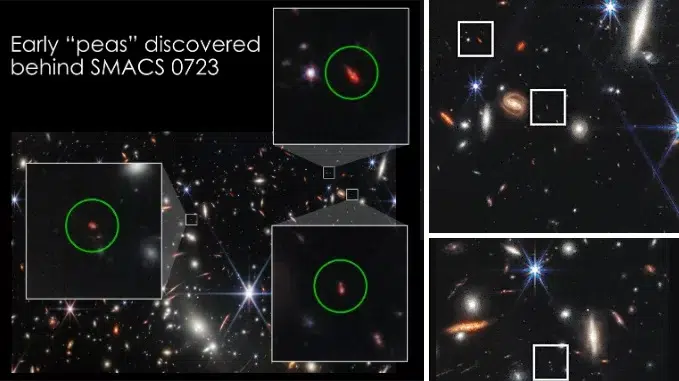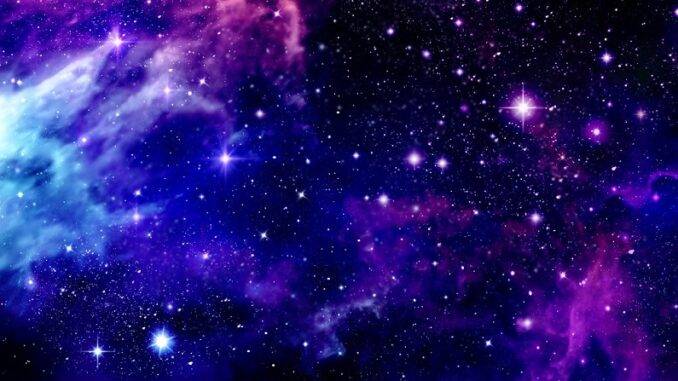
Discovering the Unseen: How NASA’s Webb Revealed Connections between Galaxies Near and Far!
Connections between Galaxies Near and Far revealed by NASA’s Webb Telescope – According to a recent analysis of distant galaxies captured by NASA’s James Webb Space Telescope, they are remarkably similar to “green peas,” a rare class of small galaxies in our cosmic backyard, and are also extremely young.
According to James Rhoads, an astrophysicist at NASA’s Goddard Space Flight Center in Greenbelt, Maryland, who presented the findings at the 241st meeting of the American Astronomical Society in Seattle, “With detailed chemical fingerprints of these early galaxies, we see that they include what might be the most primitive galaxy identified so far. At the same time, we can connect these galaxies from the dawn of the universe to similar ones nearby, which we can study in much greater detail.”
On January 3, The Astrophysical Journal Letters published a paper led by the astrophysicist James Rhoads that described the results.
The Green Pea Galaxy ‘J122051+491255’ –
Green pea galaxies were discovered and named in 2009 by volunteers participating in Galaxy Zoo, a project in which citizen scientists assist in the classification of galaxies in photographs, beginning with those from the Sloan Digital Sky Survey.
Peas appeared as small, round, unresolved dots with a distinctly green shade, which was caused by both the colors allocated to different filters in the survey’s composite images and the quality of the galaxies themselves.
Read Also- Early ‘peas’ discovered behind the Galaxy Cluster SMACS 0723 by Webb
Green pea galaxy hues are rare, distinctive, and unusual, due to the fact that a substantial portion of their light comes from brightly glowing gas clouds. In contrast to stars, which produce a spectrum of continuous color resembling a rainbow, gases emit light at specific wavelengths.

Peas are also quite compact; they are typically just 5,000 light-years across or about 5% of the size of our Milky Way galaxy.
According to Keunho Kim, a postdoctoral researcher at the University of Cincinnati and a member of the analysis team, “Peas may be small, but their star-formation activity is unusually intense for their size, so they produce bright ultraviolet light”. He also said, “Thanks to ultraviolet images of green peas from Hubble and ground-based research on early star-forming galaxies, it’s clear that they both share this property.”
How is the Webb Telescope helping NASA uncover distant galaxies?
In July 2022, the deepest and sharpest infrared image of the distant universe ever seen was released by NASA and its Webb mission collaborators, capturing thousands of galaxies in and behind a galaxy cluster called SMACS 0723.
Due to the cluster’s mass, it acts as a gravitational lens, which both enlarges (magnifies) and warps (distorts) the appearance of background galaxies.
A trio of compact infrared objects that appeared to be distant relatives of green peas was among the faintest galaxies behind the cluster. The most distant of these three galaxies was magnified by roughly ten times, giving the telescope a significant assist from nature in addition to its unprecedented capabilities.
In addition to taking pictures of the cluster, Webb used its Near-Infrared Spectrograph (NIRSpec) instrument to also capture the spectra of selected galaxies in the scene.
When James Rhoads and his colleagues reviewed these measurements and corrected them for the wavelength stretch caused by space expansion, they observed that characteristic features emitted by oxygen, hydrogen, and neon matched in a stunning resemblance to those seen from nearby green peas.

Furthermore, for the first time, the Webb spectra made it possible to measure the oxygen’s amount of these cosmic dawn galaxies.
Lighter elements like hydrogen and helium are transmuted into heavier ones by stars as they produce energy. After stars burst or lose their outer layers at the end of their lives, these heavier elements become incorporated into the gas that creates the next stellar generations, and the process continues. Stars have steadily enriched the universe throughout cosmic history.
Two of the Webb galaxies contain oxygen at about 20% of the level in our Milky Way. They resemble typical green peas, although they only make up less than 0.1% of the nearest galaxies that the Sloan survey has seen. The third galaxy under consideration is even more unusual.
According to Goddard researcher Sangeeta Malhotra, “We’re seeing these objects (early peas) as they existed up to 13.1 billion years ago when the universe was about 5% its current age”.
They are young galaxies in every sense – full of young stars and glowing gas that contains few chemical products recycled from earlier stars. Indeed, one of them contains just 2% of the oxygen abundance of a galaxy like our own and might be the most chemically primitive galaxy yet identified.
What is Green Pea Galaxy – Although the term “green peas galaxy” may seem strange and unfamiliar, it is a poetic way of expressing the beauty of our universe. The remarkable expanse of stars, planets, galaxies, nebulae and other celestial bodies can only be truly appreciated when seen with the naked eye.
From the perspective of a human, the night sky is filled with numerous points of light that form a stunning tapestry of colors and shapes. The galaxy can appear to be made of a cosmic mixture of stars and green peas due to its vibrant tint. In reality, the stars that make up the galaxy are billions of years older, but the imagery provides a unique way of appreciating our vast universe.
(Credit: SDSS and NASA, ESA, CSA, and STScI)
Read Also –
First Images from the James Webb Space Telescope
Early ‘peas’ discovered behind the Galaxy Cluster SMACS 0723 by Webb
Dark Side of Pre-stellar Ice Chemistry revealed by NASA’s Webb Space
Young Stars in Early Stages of Formation Revealed by NASA Webb (Cosmic Cliffs NGC 3324)
Southern Ring Nebula is more complex than first appears – NASA’s Webb
Exoplanet Atmosphere as Never Seen Before revealed by NASA’s Webb
Fiery Hourglass captured by NASA’s Webb as New Star Forms ‘Protostar’
Dwarf galaxy Wolf–Lundmark–Melotte (WLM) captured by James Webb Space
Early Universe MACS0647-JD Galaxy James Webb Image
James Webb Space Telescope Pair of Colliding Galaxies Image
Amazing Star-Filled Portrait of Pillars of Creation by NASA’s Webb
NASA’s Webb Telescope finds that a Star Duo Forms Fingerprint in Space
NASA’s Hubble and Webb Telescope Team Up to Trace Interstellar Dust
IC 5332 Galaxy Image by MIRI James Webb Telescope NASA
James Webb telescope New Image Neptune Rings
Red Planet Mars Images by JWST of NASA
NASA’s JWST has captured an image of Cosmic Tarantula
NASA Phantom Galaxy James Webb Space Telescope Image M74
NASA JWST Images Turned Into Sound Music
NASA Webb Space Telescope found Carbon Dioxide in Exoplanet Atmosphere
NASA JWST Jupiter Images Showcase Auroras, Hazes
NASA James Webb Space Telescope Jupiter Images Auroras, Hazes
NASA’s JWST has released crystal-clear images of Jupiter and its moons
JWST has released new images of Cartwheel Galaxy
Deepest Infrared Image of Universe from NASA’s James Webb Space
Tags: Unveiling Incredible Connections Between Galaxies revealed by Webb: NASA’s Webb Telescope Takes Us to New Frontiers!, Discovering the Astonishing Connections between Galaxies: Exploring with NASA’s Webb Telescope!
Copyrighted Material © 2019 - 2024 Prinsli.com - All rights reserved
All content on this website is copyrighted. It is prohibited to copy, publish or distribute the content and images of this website through any website, book, newspaper, software, videos, YouTube Channel or any other medium without written permission. You are not authorized to alter, obscure or remove any proprietary information, copyright or logo from this Website in any way. If any of these rules are violated, it will be strongly protested and legal action will be taken.





Be the first to comment